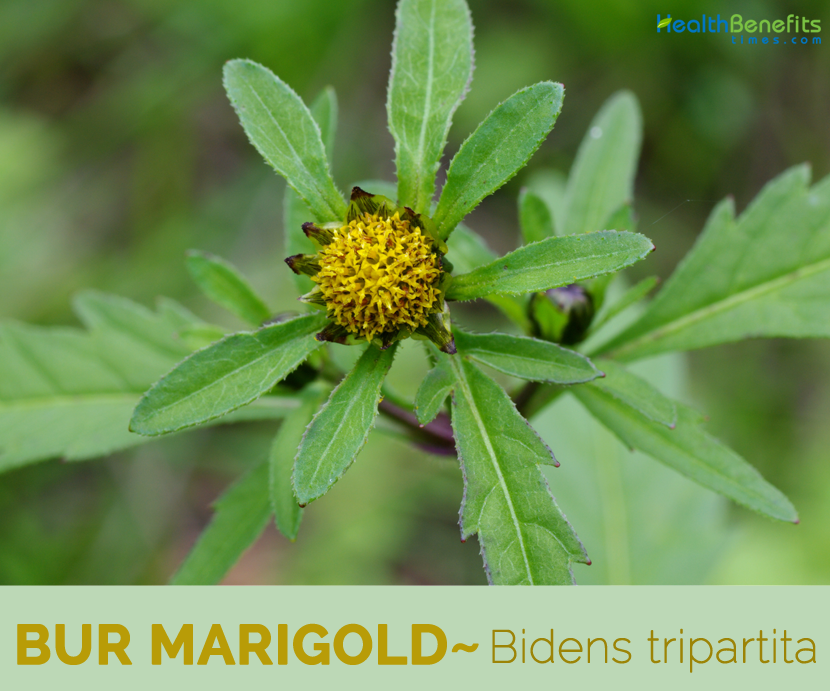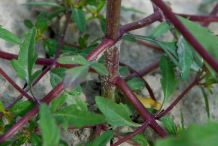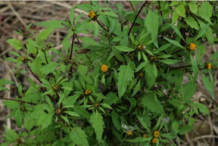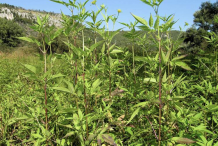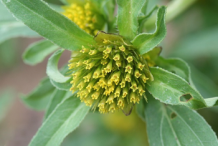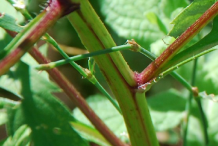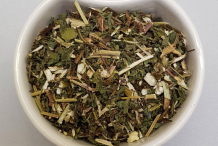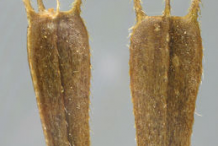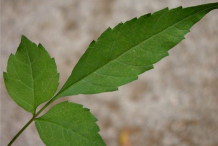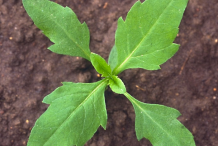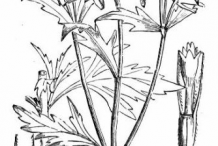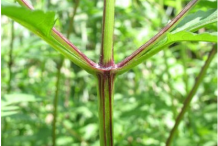Plant description
Bur Marigold is an erect, much-branched annual plant that grows about 10-60 cm (4–25 inches) tall. The plant is found growing in wetlands such as beside rivers, swamps, streams and lakes, in wet pastures, as well as in peat or gravel excavations and ditches. It grows best in moist, preferably nitrogen-rich soil, and can be commonly found near lakes, swamps, rivers, streams, and ditches. Roots are tapering, with many fibers attached to it. Stem is reddish brown or pale green erect and branched that is wiry and nearly smooth, angular, solid and marked with small brown spots. The plant can be hairy or almost glabrous, and the size of the plant (especially the leaves) depends largely on the growing location.
Leaves
Leaves are arranged alternately and are 2 to 4 inches long, ¾ to 1½ inches wide, opposite, simple, narrow to broad lance-elliptic, usually toothed, sometimes un-toothed, pointed at the tip, stalk less or tapering at the base to a (more or less) winged stalk. Occasionally a lower leaf may have one to a few lobes towards the base.
Flower & Fruit
1 to 3 stalked flower heads at the end of branching stems and arising from leaf axils. The flower center is broad, ½ to ¾ inch across, made up of tiny dull light yellow disk flowers with 4 or 5 lobes. Ray flowers (petals) are uncommon, though 1 to 5 rays, often short and stubby, may be observed. Inner bracts are relatively inconspicuous. The head is surrounded, almost rosette-like, by 5 to 13 leafy outer bracts that are variable in size, ¼ to 2½ inches long, to 2/3 inch wide, broad lance-elliptic that are typically hairy near the base and may be sparsely hairy around the edges. Flowering normally takes place from July to October. Flower heads turn into round seed heads, covered in flat, dark brown seeds. Seeds are 1/3 to ½ inch long, usually with 3 barbed awns, the middle awn shorter than the side awns. The seeds usually germinate in 2 – 3 weeks depending on the local temperatures.
Subspecies + varieties of Bur Marigold
- Bidens tripartita subsp. bullatus (L.) Rouy
- Bidens tripartita var. repens (D.Don) Sherff
- Bidens tripartita subsp. tripartita
- Bidens tripartita var. tripartita
Traditional uses and benefits of Bur Marigold
- Plant was used in fevers, gravel, stone and bladder and kidney troubles.
- The herb was previously used to treat urinary tract infections, kidney and respiratory ailment.
- According to English botanist and astrologer Nicholas Culpeper, it is helpful as a remedy for dropsy, jaundice, emaciation and other evil conditions afflicting the body.
- Herb has astringent, hemostatic and diuretic properties and can be used for various ailments related to the bladder and kidney.
- Herb may be used internally in tea form as a remedy for inflammation and minor bleeding in the urinary tract that is due to cystitis, gout, gravel or kidney stones and bleeding in the digestive tract due to ulcers, diarrhea, and ulcerative colitis.
- It has also been used as a relief for prolonged and heavy menstrual bleeding.
- It is used as a remedy for the common cold and high fever by inducing sweating.
- Whole plant is antiseptic, aperient, astringent, diuretic, emenagogue, febrifuge, narcotic, sedative, styptic and sudorific[
- It can be used in combination with sweet flag or ginger for ailments related to the digestive tract and in combination with common agrimony to halt bleeding.
- Herb can be used as a mouthwash or gargle as a relief for inflammation of the mouth and throat.
- It can be used as a wash, compresses or poultices for the treatment for eczema, ulcers, and minor skin injuries such as cuts and scrapes.
- The herb has been used as a treatment for hair loss (alopecia) in Russia.
- It has been used in traditional medicine for centuries for chronic dysentery in China.
- It was often used to treat uterine hemorrhage and conditions producing blood in the urine.
- It is used internally to treat bladder and kidney problems, blood in the urine, ulcerative colitis and peptic ulcers.
- Roots were used for scorpion bites.
- Externally, the plant is used as a wash in the treatment of chronic eczema.
- Roots and seeds are used as a remedy for kidney-stones and gallstones.
Other Facts
- Bidens tripartita was once known by the name Hipatorium due to the herb’s alleged invigorating effect on the liver.
- In the past, the dried herb was burned to keep insects at bay and it was also used as a dye plant.
- If alum powder is added, the herb yields reddish yellow to orange color.
- Burning herb repels insects and flies.
- Plant yields a black dye which is used as a hair dye.
Precautions
- Plant may cause allergic reactions in people who are hypersensitive to other plants in the daisy family (Asteraceae), such as sunflower or chamomile.
- Do not take burr marigold if you are pregnant or breast-feeding.
- If trifid bur marigold is proposed as a treatment for internal bleeding of any sorts if is vital to consult a qualified health care professional prior to use to rule out any serious illnesses.
References:
http://www.theplantlist.org/tpl1.1/record/gcc-2528
https://www.gbif.org/species/5391862
https://www.itis.gov/servlet/SingleRpt/SingleRpt?search_topic=TSN&search_value=35709#null
https://davesgarden.com/guides/pf/go/128199/
https://www.cabi.org/isc/datasheet/112698
http://www.floracatalana.net/bidens-tripartita-l-
https://www.botanical.com/botanical/mgmh/a/agrim017.html
https://plants.usda.gov/core/profile?symbol=bitr
https://www.pfaf.org/User/Plant.aspx?LatinName=Bidens+tripartita
http://wikiwel.com/wikihealing/index.php?title=Burr_Marigold
https://en.wikipedia.org/wiki/Bidens_tripartita
https://npgsweb.ars-grin.gov/gringlobal/taxonomydetail.aspx?104088
Comments
| Bur Marigold Quick Facts | |
|---|---|
| Name: | Bur Marigold |
| Scientific Name: | Bidens tripartita |
| Origin | Europe, the Indian subcontinent, North America |
| Shapes | Round seed heads, covered in flat, dark brown seeds |
| Taste | Bitter |
| Health benefits | Treat urinary tract infections, kidney, respiratory ailment, prolonged and heavy menstrual bleeding, eczema, ulcers, and minor skin injuries |
| Name | Bur Marigold |
|---|---|
| Scientific Name | Bidens tripartita |
| Native | Europe, the Indian subcontinent, North America, temperate east Asia, and slightly into northern Africa |
| Common Names | Three-lobe Beggarticks, Three-part Beggarticks, Leafy-bracted Beggarticks or Trifid Bur-marigold, Bur marigold, water agrimony, tickseed, Bastard agrimony , bastard hemp , bur marigold , hairy beggar-ticks , 3-lobe beggar ticks , lumb , needle grass , Spanish needles , sticktights , water hemp |
| Name in Other Languages | Albanian: Dydhëmbësh tripjesësh Arabic: Husaykat thulathiat al’aqsam ( حُسَيْكَة ثُلاثِيَّة الأَقْسام) Bulgarian: Tridelen butrak (триделен бутрак) Catalan: Bident tripartit Chinese: Láng bà cǎo (狼杷草), Yèchā tóu (夜叉头),Guǐ cì (鬼刺), Guǐ chā (鬼叉), Guǐ zhēn(鬼针) Croatian: Trodijelni dvozub Czech: Dvouzubec trojdílný Danish: Fliget brøndsel Dutch: Veerdelig tandzaad, driedelig tandzaa English: Erect-bur-marigold, Marigold-bur, Threelobe beggarticks, Trifid bur-marigold, Water-agrimony, Three-parted beggarticks, Straw-stemmed beggarticks, Three-lobed beggarticks, Trifid burr marigold, three-cleft bur-marigold, tripartite bur-marigold, bur beggarticks, leafy-bract beggarticks Estonian: Kolmisruse Finnish: Tummarusokki French: Bident triparti, Bident à trois divisions, Bident trifoliolé, Bident tripartite, Bident à feuilles tripartites, Bident à trois arêtes, Bident à trois folioles, Eupatoire aquatique, bident hérissé, chanvre d’eau, cornuet German: Dreiteiliger Zweizahn, Ackerzweizahn, Breitblattzweizahn, Dreiblattzweizahn, Dreiteilzweizahn, gewöhnlicher Zweizahn, Sumpfzweizahn Hebrew: Du=shen meshullash, דּוּ=שֵׁן מְשֻׁלָּשׁ Hungarian: Subás farkasfog Italian: Canapa acquatica, canapina acquatica, forbicina commune Japanese: Ta-ukogi (タウコギ) Latvian: Trejdaivu sunītis Lithuanian: Triskiautis lakišius Norwegian Bokmål: Flikbrønsle Nynorsk, Norwegian: Flikbrønsle Occitan: Canebe sauvage Polish: Uczep zwodniczy Romanian: Dentiţă, dentiță tripartită Russian: Cereda trechrazdel’naja, tsereda tretskhrazdel’naya (цереда трецхраздельная) Serbian: Obični dvozub (обични двозуб), трођелни двозуб Slovak: Dvojzub trojdielny Slovene: Tridelni mrkač Spanish: Canamo acuatico Swedish: Brunskära, Tummarusokki Turkish: Uç suketeni Ukrainian: chereda skhidna (череда східна), череда трироздільна |
| Plant Growth Habit | Erect, much-branched annual plant |
| Growing Climate | Wetlands such as rivers, swamps, streams and lakes, in wet pastures, as well as in peat or gravel excavations and ditches |
| Soil | Grows best in moist, preferably nitrogen-rich soil, and can be commonly found near lakes, swamps, rivers, streams, and ditches |
| Plant Size | 10-60 cm (4–25 inches) tall |
| Root | Tapering, with many fibers attached to it |
| Stem | Reddish brown or pale green erect and branched stem that is wiry and nearly smooth, angular, solid and marked with small brown spots |
| Leaf | Arranged alternately and are 2 to 4 inches long, ¾ to 1½ inches wide, opposite, simple, narrow to broad lance-elliptic, usually toothed, sometimes untoothed, pointed at the tip, stalkess or tapering at the base to a (more or less) winged stalk |
| Flowering Periods | July to October |
| Flower | Terminal heads, brownish-yellow in colour and somewhat drooping, usually without ray florets the disk florets being perfectly regular. The heads are surrounded by a leafy involucre, the outer leaflets of which, about eight in number, pointed and spreading, extend much behind the flower-head. |
| Fruit Shape & Size | Round seed heads, covered in flat, dark brown seeds. |
| Seed | 5-8 mm long and are equipped with two (rarely three) reflexed prickles. |
| Varieties/Types |
|
| Taste | Bitter |
| Plant Parts Used | Whole plant |
| Available Forms | Extracts, herbal teas, and tinctures |
| Culinary Uses |
|


